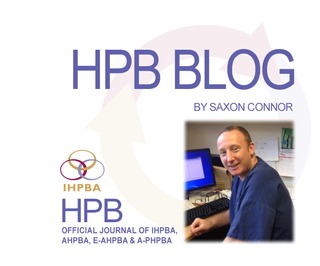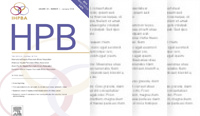International Hepato-Pancreato-Biliary Association
HPB Blog, July 2018

The rise of big data
Reading this month’s articles made me realise how enjoyable it is to be part of a team that helps collate and present the academic HPB communities’ hard work for the enjoyment and education of the wider profession. The editorial team’s aim is to present articles that are concise, effortless to read and digest, and hopefully leave you reflecting on your own practice. All at a time when people’s time for “thinking and reflecting” is ever decreasing. We are grateful to the authors who work with us to try and meet these aims by repeatedly revising and fine tuning their articles. Hopefully with this month’s offering we can entice you to spend some quality “thinking time” or alternatively use this month’s articles as an easy way to collate an interesting journal club for your department and colleagues.
I want to spend most of the blog focusing on four studies which use “big data” in slightly different ways. The first by Lyu et al which analysed the outcomes of 9195 patients undergoing liver resection with the aim of identifying patients and the risk factors for reoperation. The incidence of reoperation was 4% at 30 days. The more difficult or significant the operation was, the more likely it was that reoperation was required. Haemorrhage was the commonest reason for reoperation. This is a good paper from which to benchmark your own practice. Fadayomi et al have used a sample of 8093 patients who underwent pancreatectomy in NSQIP database to identify the different risk factors for superficial and deep surgical site infection (SSI), again this can be used to benchmark your own practice but it also offers insight into the underlying etiology, with superficial SSI related to the presence of a biliary stent and length of operation – raising the question about the type and timing of antibiotic use. In contrast, deep SSI was related to the underlying risk of the pancreatic remnant, highlighting the importance of the work that needs to be done on understanding the true pathophysiology of POPF rather than just risk factors. Lemke et al have used NSQIP for another purpose; to validate a three point scoring system to predict the need for blood transfusion during hepatectomy. The three factors were preoperative haematocrit <36%, major hepatectomy and primary liver malignancy. If you were in the high risk group or beyond, the risk of transfusion was 35-40% compared with only 8% in the low risk group. The degree of fit was graded as good in a general population suggesting this has utility. Given that only one factor is modifiable preoperatively it would seem important to be paying attention to and addressing preoperative anaemia. Beal et al also used the NSQIP database and identified nearly 50000 patients undergoing hepatic or pancreatic surgery. This is a fascinating study as it starts to show us the power of large data but also highlights the limitations when the dataset is incomplete. The authors come up with a model which would allow surgeons to accurately identify those patients who do not need prolonged prophylaxis (NPV=99.5%), yet the limitation of this conclusion is that it was unknown how many of these patients had prior DVT or what form of DVT prophylaxis they had received. These data will be in the patient’s electronic medical record (EMR). Solving the issue of siloed data remains a challenge for most health systems but is the key to unlocking the true power of big data. These are obviously key points and leave me wondering can I implement this model? If so, how do I build this model into the clinical decision support of our local EMR. The model uses continuous variables rather than binary answers and so ideally the solution should “pull data automatically” to optimise the usability for those at the frontline, again the issue of connected data. Successful use will also require presentation of this information in meaningful way to front-line clinicians, not just statistical numbers. The model also contains three subjective variables in the form of ethnicity. This raises questions for those of us who live in countries with a different genetic racial make-up and cultural definition of ethnicity subtypes to the USA.
For those with a technical bent then can I suggest Aghalarov et al’s paper on modified single loop reconstruction for Pancreaticoduodenectomy, Lemaire et al’s paper on use of SIRT prior to hepatectomy or ablation for HCC or the paper by de Jong et al on a liver first approach for colorectal liver metastases.
For those in the transplant space two articles are worth investing time, the first by Czerwonko et al looking at outcomes for liver transplant patients with and without post-transplant liver abscess. The key messages here are the risk factors relating to technical issues such as hepatic artery thrombosis, long organ ischaemic times and presence of a hepaticojejunostomy. Perhaps more importantly though was the significant reduction in survival with a 5 year survival of only 49%. Brooks et al looked at the effect of a process change to the allocation of livers for re-transplantation which improved both the wait list mortality and the overall 2 year survival- a win-win situation indeed.
For those following translational basic science then the article looking at exosome isolation from pancreatic duct fluid by Zheng et al should be on your radar. This may well have potential for preoperative assessment of pancreatic cystic lesions.
Van Veldhuisen and colleagues from Amsterdam highlight the difficulty of deciding on who to resect following induction chemotherapy for locally advanced pancreatic cancer. It would seem that Ca19-9 and its response may be a useful guide for both resectability and long term survival.
Finally for those who enjoy reading about rare lesions (lymphoepithelial cysts of the pancreas) should read an excellent article combining original data and review of the literature by Groot et al.
Saxon Connor
Corporate Partners
If you are interested in becoming a Corporate Partner of the IHBPA please contact industry@ihpba.org
Find out more


